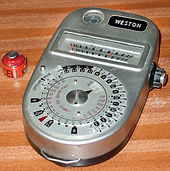
Rangers and Strangers
The 'Master' family of exposure meters were not the only ones to appear in the post-war range of Westons. In the '50s A licence was granted by Daystrom, the owners of Weston Instruments at the time, to the Japanese manufacturer, Sekonic, who produced three models replicating the Master II, Master III and Master IV. They bore the names Sekonic Uinversal and Sekonic Master. Some of the Model IVs indeed bore the name 'Weston' and the manufacturer's name 'Sekonic' is not present. No doubt, these would have been requested by Daystrom for direct sale in continental America. Two of the Sekonic models are in my collection. Sekonic also produced a budget version of their LIII Professional, which they designated the L-3b. This appears under the name 'Anglo' (as in Anglo L-3b) and this probably would have been marketed by Anglo Photographics in Canada. It also appears directly with the Sekonic name. It is unlikely that these models were licensed or distributed by Daystrom.
After the Master III, The Newark factory in the U.S.A. made just two more models of exposure meter, neither of which were in the 'Master' family and both representing a significant departure from previous design directions:
The 'Ranger 9' is out on its own and cannot be compared to any other Weston meter - or indeed any other manufacturer's design. In the USA, this was the Weston company's only implementation of the then new technology of the Cadmium Sulphide (CdS) photo-resistive cell. Precision made, the meter sports a viewfinder to direct the cell's narrow capture angle. This model is still present on auction sites today in full working order. They are not easy to use however, being dependent on an obsolete mercury battery.
In 1968, Newark designed and sold their last model of meter - the Pixie. This refers back to the design philosophy of the Direct Reading (DR) series produced much earlier. Again this budget manufacture disc-shaped meter bears no resemblance to any other design. A simple rotating outer dial reads off apertures for a small range of Kodak still camera and movie films of the time.
Two more models were made bearing the Weston name, but not in America or Britain. These were the XM1 and XM2 designed and produced in Japan, under license, by Sekonic. Of cheap manufacture and design, and unlike the previous Sekonics, these display the Weston name and do not mention Sekonic. At a glance they look identical. The XM2 however is a CdS version of the Selenium cell XM1. The Ranger 9 and XM2 are therefore the only Westons ever to use the CdS cell.
Sekonic Universal Exposure Meter Model
L - III Professional
Japan
1953
This model was made by Sekonic in Japan under licence from Weston. Similar to the Master II, it uses the ASA film speed ratings in place of Weston speeds, putting it 3 years ahead of the Master III. A conversion table between the two systems is embossed on the meter back. Also has a push button meter needle lock release.
Sekonic Master Exposure Meter Model L-104
Japan
1960
The third model made by Sekonic is virtually identical to the Weston Master IV. It features the inwards-facing pointer on the dial and a black slider for the meter needle lock. Aluminium top casing and black chassis. The perforation spacing on the baffle returns to the Weston pattern. INSTRUCTION MANUAL FOR SEKONIC L-104
USA
1966
A complete departure for Weston into Cadmium Sulphide (CdS). Requires obsolete PX14 button mercury battery. Narrow capture angle, visual sighting scope. Dual range and meter needle lock release button. ASA speeds and Exposure Values. Large size. A push-on Invercone provided Incident light capability. Mercury-free replacement batteries.
USA
1968
Much simplified model, similar in concept to the earlier Direct Reading models. Outer dial selects between 4 popular Kodak films: Kodachrome II Movie, Kodachrome II still, Kodacolor X & Plus X pan. Apertures are read off for a reference shutter speed of 1/125th sec. User must adjust for other speeds. Reflected light use only.
Weston XM1 Exposure Meter Model 540
Japan
1972
Compact Japanese Weston made under licence by Sekonic. Budget manufacture with a well designed dial. Single range, ASA film speeds and Exposure Values. Also marked up for Movie in frames per second. Simple ten unit scale meter range.
Japan
1972
In outward appearance, completely indistinguishable from the XM1. But the XM2 is Sekonic's Cadmium Sulphide (CdS) version of the Selenium-celled XM1. A slip-over invercone allows for incident light readings and the four-way sliding side switch gives dual range, on/off and battery check.
USA
1955
This accessory was one of few made not by Weston, but by a third-party American company - Harrison - for use with the Weston Master family of meters. Locking over the un-baffled cell, an adjustable blind, red and blue filters are manipulated. The offset meter reading is then used to calculate colour temperature.
USA
1955
The complete set of 22 filters for the Harrison Exposure and Color Temperature Attachment (above) boxed in hardwood and with a reference table listing the filter steps from B & C 1/8 to 8. Each filter is optical acetate sandwiched between optical glass, each housed in a separate felt-lined aluminium can.
Japan
1960
A Seconic manufactured budget version of the classic Weston Master Universal model II. It has a cell baffle for dual range operation but no rotating legends on meter face. Has a push button needle lock as with other Sekonics and the model designation L3-b differentiates it from Sekonic's L-III Professional. Also sold directly by Sekonic using their own name.
USA
2025
A vinyl overlay for use on the Ranger 9 CdS exposure meter giving support for the Ansel Adams Zone exposure system. This is a modern product manufactured in the USA by James Rinner, (See his Etsy site here). Ebay Store Here. Instructions for fitting.













